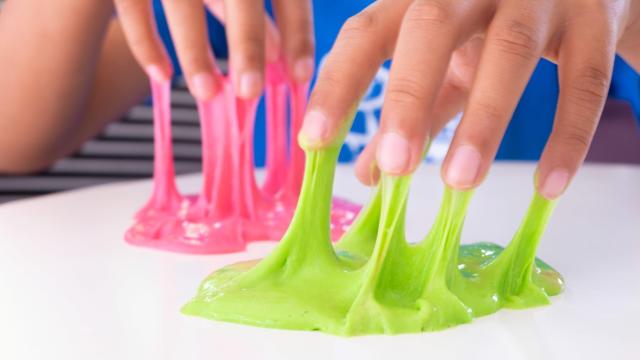In my house, we don’t do slime. Its slick, viscous texture has horrified me from the start, not only for its germ, dirt, and hair-collecting nature, but for the way it clings mercilessly to every substance it comes in contact with. On occasion, though, one of my kids comes home from school or a birthday party with slime, so resisting my instincts to discard it immediately, I have settled for a strict “only in the kitchen” rule.
Which is why, when my daughter recently returned from an excursion with her dad and a friend, it was the first time in nine years of parenting that I’d had to contend with getting slime out of clothes. When I saw her vehemently scrubbing with a dry washcloth at what she called “putty” (yeah right, slime marketers, you can call it putty, but it is still coloured glue), I hit up Google for instructions.
How to remove wet slime
Wet slime is apparently easier to remove than dry slime (I couldn’t tell you firsthand because I didn’t have the pleasure of being gifted wet slime.) First, remove as much as you can before it dries. Then soak it in white vinegar for ten minutes before using an old toothbrush to scrub the area in a circular motion. Rinse with hot water and launder as usual. (If slime dye is left behind, liberally apply stain remover — or bleach diluted with water if it’s a white garment — and let sit for 15 minutes before washing.)
How to remove dry slime
Once the goop has had a chance to dry, it’s a whole different ball game. The first generally recommended step is to scrape as much as you can off with a butter knife. (It will not be much.) Various follow-up techniques are recommended, most of which I tried. See results below.
Apply ice (or use the freezer)
There are those who say applying ice to the affected area can harden slime for easier removal; others say leaving the affected garment in the freezer for 3-4 hours will achieve the same goal. I’m not sure about direct ice application, but when it comes to the freezer trick they are wrong. After four hours, the stuff barely budged. (I checked the freezer temp, and it was 5 degrees Fahrenheit, not the recommended 0 degrees. Maybe those extra five degrees made it too tropical?)
Soak in vinegar
When the freezer bath did nothing, I soaked the leggings in vinegar for 10 minutes then attempted brushing off slime with a toothbrush, per the above instructions. While this technique may be effective on wet slime, on freeze-dried slime, all it did was somewhat artfully smush the slime further into the pant, à la Van Gogh’s Starry Night.
Use dish soap (or laundry detergent)
Enter liquid dish soap, a miracle whose praises we have sung before. Now, we can add slime removal to its list of cleaning glories. A few focused drops followed by vigorous scrubbing like the olden times and wouldn’t you know, with a little scraping from ye olde fingernails, that stuff peeled right off? Whether the dish soap would be this effective straightaway, rather than as a follow-up to vinegar and warm water, I can’t say. But I can recommend starting here first.
Rubbing alcohol, acetone, nail polish remover
If all else fails, try dabbing a cotton ball soaked with rubbing alcohol, nail polish remover, or pure acetone to lift the slime bit by bit — it should stick to the cotton ball. Keep in mind these are much stronger, more astringent substances and should be tested on a small piece of fabric first.
Getting slime out of upholstery
The same substances can be used to lift slime from your family couch. Maids.com recommends removing as much of the slime as possible by working it up and away from the fabric, without scrubbing. (A spoon can be effective.) Then mix 2/3 cup white vinegar with 1/3 cup water in a spray bottle. Spray the surface, let it soak in for 10-15 minutes before using a soft brush to work the solution into the fabric. Rinse with water, pat dry — and banish slime from your house forevermore.

Leave a Reply
You must be logged in to post a comment.